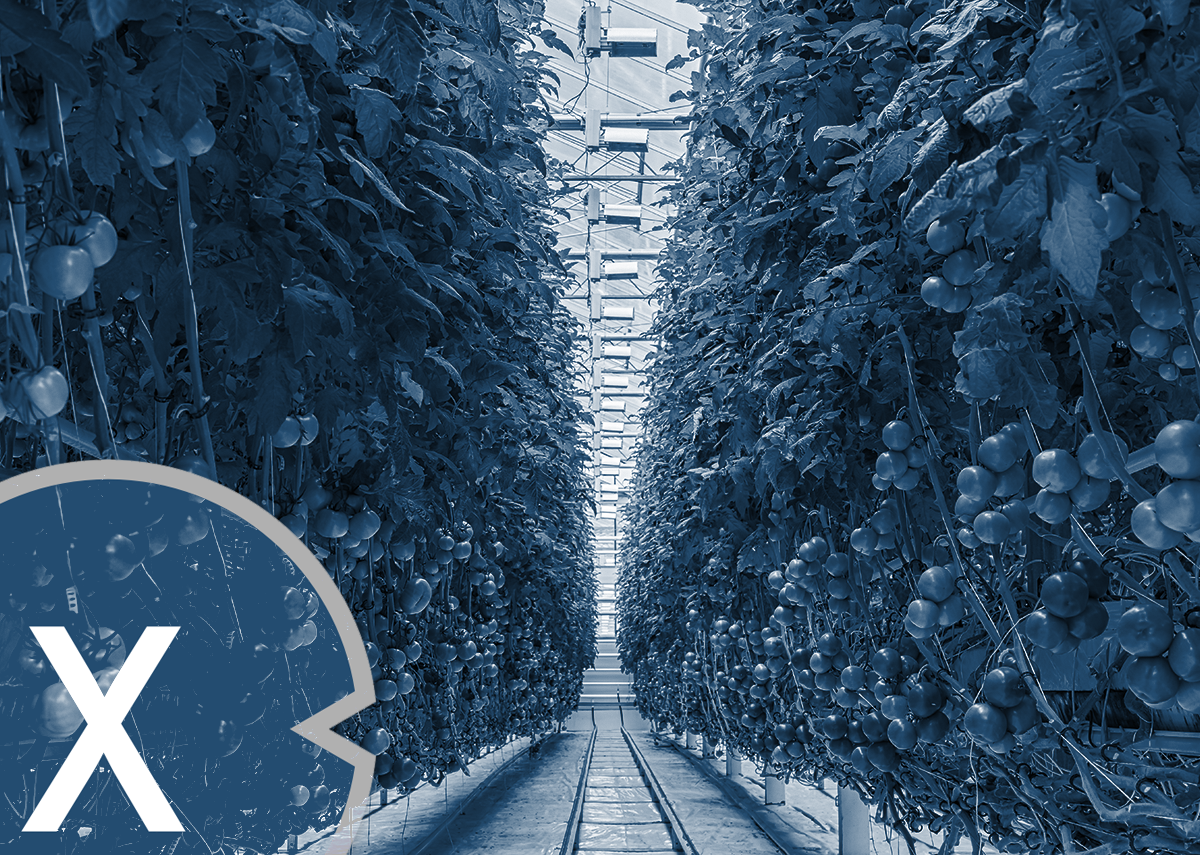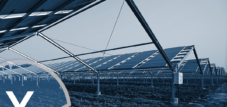For greenhouses: The solar hybrid system 'solar greenhouse'
Greenhouse Solar or solar greenhouses are innovative solar hybrid systems in which solar modules are integrated into greenhouses to optimize both plant growth and energy production. This technology combines the benefits of greenhouses, which provide a controlled environment for plant growth, with the use of renewable solar energy.
The solar greenhouse uses special solar modules that are partially transparent and can both transmit sunlight and generate energy. These solar panels are installed as either roof cladding or facade cladding to utilize the structure of the greenhouse.
The combination of solar panels and greenhouses offers numerous advantages. Firstly, the use of solar energy enables a sustainable energy supply for the solar greenhouse. The solar modules generate clean energy that can either be used on site or fed into the power grid. This can reduce energy costs and reduce dependence on conventional energy sources.
Secondly, the solar greenhouse improves energy efficiency. The semi-transparent solar panels allow natural sunlight to penetrate the greenhouse, promoting plant growth while generating energy. This reduces the need for artificial lighting and leads to savings in energy costs.
In addition, the solar greenhouse offers better control over the microclimate. The solar panels serve as sun protection and regulate solar radiation, which reduces overheating of the plants. At the same time, they help to retain heat in the greenhouse and thus reduce energy consumption for heating.
Another advantage of the solar greenhouse is the possibility of storing energy. By using battery storage, excess solar energy can be stored during sunny periods and used later when energy needs are higher. This ensures a continuous energy supply for the greenhouse.
The development of solar greenhouses has great potential for the future of agricultural production and sustainable energy production. By maximizing the use of sunlight and incorporating solar panels into greenhouses, farms can reduce their energy costs, increase productivity and help reduce greenhouse gas emissions.
It is important to note that the planning and design of solar greenhouses must be done carefully to achieve the optimal balance between light transmission, energy production and plant growth.
Plan your solar system for the most common applications conveniently online with our solar system planner!
With our user-friendly solar system planner you can plan your individual solar system online. Whether you need a solar system for your home, your business or for agricultural purposes, our planner offers you the opportunity to take your specific requirements into account and develop a tailor-made solution.
The planning process is simple and intuitive. You simply enter relevant information. Our planner takes this information into account and creates a tailor-made solar system that meets your needs. You can try out different options and configurations to find the optimal solar system for your application.
Additionally, you can save your plan to review later or share with others. Our customer service team is also available to answer your questions and provide support to ensure your solar system is optimally planned.
Use our solar system planner to plan your individual solar system for the most common applications and advance the transition to clean energy. Start now and take an important step towards sustainability and energy independence!
The solar system planner for the most common applications: Plan the solar system online here - Image: Xpert.Digital
More about it here:
The development of Greenhouse Solar
The development of greenhouse solar systems, also known as Greenhouse Solar, has made significant progress in recent years and is seen as a promising technology for the future of agricultural energy production. Greenhouse solar refers to the integration of solar panels into greenhouses to both generate renewable energy and support plant growth.
The advantages of Greenhouse Solar are many. First, the combination of solar energy and greenhouses allows for efficient use of limited space. Greenhouses are already designed to provide an optimal environment for plant growth. By integrating solar panels into the roof structure of the greenhouses, additional benefits are gained from the available space as the solar panels generate energy at the same time.
Secondly, Greenhouse Solar offers agricultural businesses a sustainable energy supply. The solar panels in the greenhouses generate clean and renewable energy that can either be used on site or fed into the power grid. This can reduce energy costs and reduce dependence on conventional energy sources.
In addition, Greenhouse Solar can improve the microclimate in the greenhouses. The solar panels serve to protect the plants from excessive sunlight and help regulate the temperature and humidity inside. This can lead to better control of growing conditions and increase agricultural production yields.
Another advantage of Greenhouse Solar is the ability to store energy. By using battery storage, excess solar energy can be stored during sunny periods and used later when energy needs are higher. This ensures a continuous supply of energy for the greenhouse, even if the solar radiation fluctuates.
The future of Greenhouse Solar looks promising. The increasing demand for renewable energy, the focus on sustainability in agriculture and the need to reduce energy consumption are driving the development and implementation of Greenhouse Solar. New technologies and systems are continually being developed to optimize the integration of solar panels into greenhouses and maximize energy production efficiency.
It is important to note that the implementation of Greenhouse Solar requires careful planning and integration to ensure the optimal conditions for plant growth and energy production. Collaboration between the solar energy and agricultural industries is crucial to develop best practices and achieve the best possible results.
The combination with partially transparent solar modules
Partial transparent solar modules are increasingly used in the area of the “Greenhouse Solar” to combine the advantages of greenhouses with energy generation by solar modules. Greenhouse Solar refers to the integration of solar modules in greenhouses in order to generate clean energy and at the same time ensure optimal conditions for plant growth.
The partially transparent solar modules are installed either as roof cladding or as facade cladding in the greenhouse. They allow some of the sunlight to pass through while at the same time generating energy. This allows the use of natural lighting for plant growth and reduces the need for artificial lighting.
The use of partially transparent solar modules in Greenhouse Solar offers several advantages. Firstly, solar energy production in the greenhouse enables a sustainable energy supply. The solar modules generate clean energy that can be used on site or fed into the power grid. This can reduce energy costs and reduce dependence on fossil fuels.
Secondly, the partially transparent solar modules support plant growth in the greenhouse. By allowing part of the sunlight to pass through, they contribute to the natural lighting of the plants and thus promote their development. At the same time, the solar modules protect the plants from excessive sunlight and thus offer better control over the microclimate in the greenhouse.
Furthermore, the partially transparent solar modules in the Greenhouse Solar enable efficient use of space. Since the solar modules serve as roof or facade cladding, the limited space in the greenhouse is used optimally. This allows farms to generate income from both crop production and solar energy production.
The combination of greenhouses and solar energy through semi-transparent solar modules in Greenhouse Solar shows promising prospects for future agriculture and energy production. By maximizing the use of sunlight, reducing energy costs and producing sustainably, farms can increase their profitability while contributing to climate protection.
It is important to note that the selection and installation of semi-transparent solar panels in the greenhouse must be carefully planned to achieve the optimal balance between light transmission, energy production and plant growth. Collaboration between solar experts and farmers is crucial to develop tailored solutions and maximize the benefits of Greenhouse Solar.
The advantages of a solar greenhouse using tomatoes as an example
A solar greenhouse offers many benefits for growing tomatoes and can result in a significant increase in productivity and quality of the crop. Here are some important advantages of a solar greenhouse using tomatoes as an example:
Extended growing season
A solar greenhouse allows tomatoes to be grown over a longer period of time. By controlling temperature, humidity and light levels in the greenhouse, tomatoes can be grown outside of the normal season. This enables year-round production and a continuous crop yield.
Optimal growth conditions
In a solar greenhouse, the environmental conditions can be tailored precisely to the needs of the tomato plants. Temperature can be maintained at an optimal level and humidity can be controlled to promote healthy plant growth. Additionally, pests and diseases can be better controlled because the greenhouse creates a physical barrier.
Protection from the elements
A solar greenhouse offers effective protection against unfavorable weather conditions such as strong wind, hail, heavy rain or extreme heat. Tomato plants are sensitive to such weather conditions, and a greenhouse provides them with a protected space to develop optimally.
Energy efficiency
By integrating solar modules into the greenhouse, the energy supply for lighting, ventilation and heating can be made more efficient. The solar panels generate clean energy from sunlight, which can reduce energy costs and improve the sustainability of operations.
Higher crop yields
By creating an optimal growing environment in the solar greenhouse, higher crop yields can be achieved. The controlled conditions allow for better control of nutrient balance, irrigation and light levels, resulting in healthier and more productive tomato plants.
Better product quality
The controlled environment in the solar greenhouse can lead to an improvement in the quality of the tomatoes harvested. Precise control of light, temperature and humidity allows for even ripening and better development of the tomatoes' flavor, color and texture.
➡️ A solar greenhouse offers a variety of benefits for growing tomatoes, resulting in increased productivity, a longer growing season and better product quality. It is a sustainable and efficient solution that meets the needs of tomato farmers and can increase the yield of their crop.
- Plan photovoltaics for warehouses, commercial halls and industrial halls
- Industrial plant: Plan a photovoltaic open-air system or open-space system
- Plan solar systems with photovoltaic solutions for freight forwarding and contract logistics
- B2B solar systems and photovoltaic solutions & advice
Greenhouse Solar: Your individual solar greenhouse with Xpert.Solar
I would be happy to serve as your personal advisor.
You can contact me by filling out the contact form below or simply call me on +49 89 89 674 804 (Munich) .
I'm looking forward to our joint project.
Xpert.Digital – Konrad Wolfenstein
Xpert.Digital is a hub for industry with a focus on digitalization, mechanical engineering, logistics/intralogistics and photovoltaics.
With our 360° business development solution, we support well-known companies from new business to after sales.
Market intelligence, smarketing, marketing automation, content development, PR, mail campaigns, personalized social media and lead nurturing are part of our digital tools.
You can find out more at: www.xpert.digital – www.xpert.solar – www.xpert.plus


